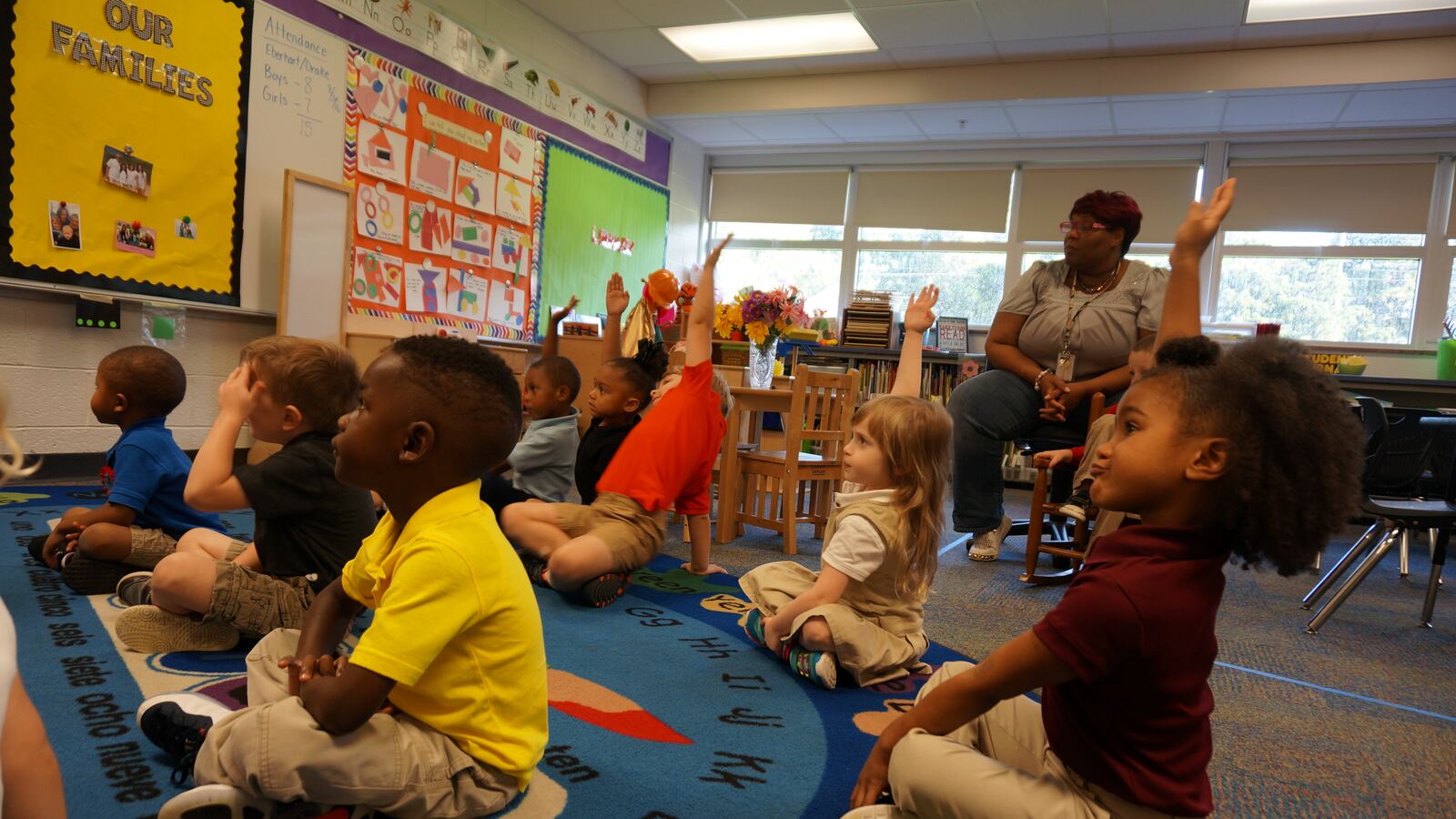This is the latest entry in How We Got Here, a series where students and families explain how they chose, or ended up at, the schools they did. You can see all of the stories here.

Unlike many of the other mothers I know, I’m not wringing my hands too much about where I send my children to school.
Now that our children are approaching kindergarten, women I’ve known for a long time are growing anxious. We all want to do what’s best for our kids, but our choices are limited by our finances and sometimes by school districts. Some of us also have concern for social and racial justice and how that is reflected in our schools, and want to make choices for our own children that contribute to a more just school system.
I’m an anxious person by nature, but as a teacher in the public schools in Nashville as well as a parent, I’m not nervous about where my children end up.
My surprisingly chill perspective comes mostly from a recognition of my privilege. My kids are little white boys with two married, employed, home-owning, college-educated parents. They have so much privilege. Every statistic there is says they will be just fine, no matter where they go to school. My students have very few of these advantages, and I see every day that they are people with intelligence, integrity, humor, and optimism. Accepting my students for who they are helps me to accept that my children will be OK, even if they don’t get every single advantage I had.
In fact, it will be a good thing for my boys to learn alongside children who are different from them in many ways — that is one advantage they will have that I did not, attending parochial schools in a lily-white suburb. Actually, growing up in a less homogeneous community than I did will give them an important set of skills and dispositions that will help them in an increasingly diverse world. I hope they’ll grow up in a country where their privileges — their skin color and their parents’ status — matter less and less, while their skills and work ethic matter more and more.
Given all that, our plan is to enroll our kids in the neighborhood public schools — starting with pre-kindergarten this month for our older son. Our kids are 4 and 1, schools can change quickly, and I can’t predict the future, so I’m not promising now that my kids will eventually graduate from their zoned public schools. But I am saying that this will be our first choice, one we will only deviate from for very compelling reasons. Too many other families in Nashville and beyond don’t even give public schools this much of a chance, scared by reputation and rumors into opting for private, charter, and magnet schools before investigating the neighborhood public schools for themselves.
Sometimes during these conversations among parents, even after I say something about how my privileged kids will be OK and how diversity is good, the other moms continue their hand-wringing. Why? Sometimes it’s because their children have challenges mine do not; because they have less privilege than I do; or because they are afraid that even the privilege they have will not be enough to position their children favorably in a rapidly changing world.
These fears are understandable. But sadly, I’m also afraid that some of their anxiety is because of implicit bias that these good-hearted women don’t want to recognize within themselves. This is what’s usually buried under the surface of talk about “good schools”: so often, white parents define “good schools” as schools full of white kids.
My personal rule of thumb when assessing schools is inspired by This American Life’s 2016 episode “The Problem We All Live With,” which explored the troubling history of school segregation, desegregation, and resegregation in communities like mine. When I evaluate schools for my kids, I look for them to be truly integrated — to have at least 25 percent students of color and at least 25 percent white students. In the episode, a quarter of the population seemed to be the threshold where minority students were no longer tokens, and where white parents were numerous enough to fight for the school to get the needed resources from higher up (because, sadly, school boards and districts often disregard the concerns of parents of color, while paying attention to their white constituents).
In diverse counties like mine, this 25 percent rule makes a pretty low threshold, a goal that should not be incredibly difficult to achieve. Studies show that students of color see their test scores improve in integrated classrooms, while white students fare no differently. In many ways, integration would be one of the easiest strategies for “closing the achievement gap.”
Liberal parents sometimes struggle when it feels like they have to choose between what’s best for their own kids in the short term and what’s best for the system as a whole in the long run. But I like the point that Nikole Hannah-Jones, the black journalist behind the This American Life episode, has made when discussing her own choice for her daughter’s schooling: Her child is no better or more deserving than any other child, so it’s wrong to say that a school isn’t good enough for her child, but fine for other kids. In a way, insisting on one’s own children’s right to attend “better” schools is a selfish choice if it results in the deterioration of schools that other, less fortunate children depend on. New York City teacher Jose Luis Vilson wrote a similar essay about his own family’s choices. My particular situation isn’t the same as these writers’, but I found their stories compelling and persuasive.
I wish our school system in Nashville didn’t have big pockets of de facto segregation — that might be my top wish as both a parent and a teacher, surpassing even my desire for higher teacher pay and better family policies. There are schools in our district that are over 90 percent African American that gain a reputation for being “bad schools,” even “dropout factories,” while the expensive private school down the road (not coincidentally founded soon after enforcement of Brown v. Board, the landmark school desegregation case) is over 90 percent white and has “Blue Ribbon” status.
Recently, most debates about school segregation in Nashville have been just a small part of a larger debate on charter schools, a topic that has dominated school board politics. One argument against the schools is that they intensify segregation in the district as a whole by targeting narrow populations; their defenders respond by pointing out that the racial makeup of charter schools is not significantly different from that of the other nearby zoned schools.
Meticulous number-crunching is necessary to try to adjudicate that debate. Personally, I think that whole argument is more pertinent to magnet schools, which screen students based on their skills, than to charter schools, and magnet schools certainly are not going anywhere. But the effect of any school or type of school on the district’s racial makeup seems a moot point when the fact is that the system as a whole is deeply segregated, and most individual schools reflect that.
This situation is only poised to get worse as our rapidly gentrifying city adds more expensive housing developments, potentially deepening the residential segregation that already exists (and has deep historical roots). I’m afraid that left to its own devices, the free market will intensify residential segregation and displace many longtime residents, especially people of color and the poor, with a side effect of intensifying segregation in schools. Mixed-race and mixed-income neighborhoods are so crucial because they make desegregated schools happen more conveniently, organically, and peacefully, without tortured debates or elaborate busing plans.
The education activist groups I’m in haven’t been talking much about desegregation and busing, though I know they care deeply about racial justice. I know and trust these people, and I feel confident that the reason this issue hasn’t come up is that we are fighting a war on multiple fronts. We’re teachers trying to protect our jobs, we’re working to elect a school board that hasn’t been bought and paid for by out-of-state special interests, we’re trying to keep charter schools from taking students away, and we’re fighting to keep standardized testing from taking over every minute of every school day. Also, I know I’m a relative newcomer to town (I moved here in 2008), and there may be a fraught history here that I’m unaware of. Desegregation is politically tricky, and it’s something we haven’t fought for. But I would love to see that change.
Mary Jo Cramb is a teacher and parent in Nashville. A version of this piece first appeared on the Nashville education blog Dad Gone Wild.
About our First Person series:
First Person is where Chalkbeat features personal essays by educators, students, parents, and others trying to improve public education. Read our submission guidelines here.

